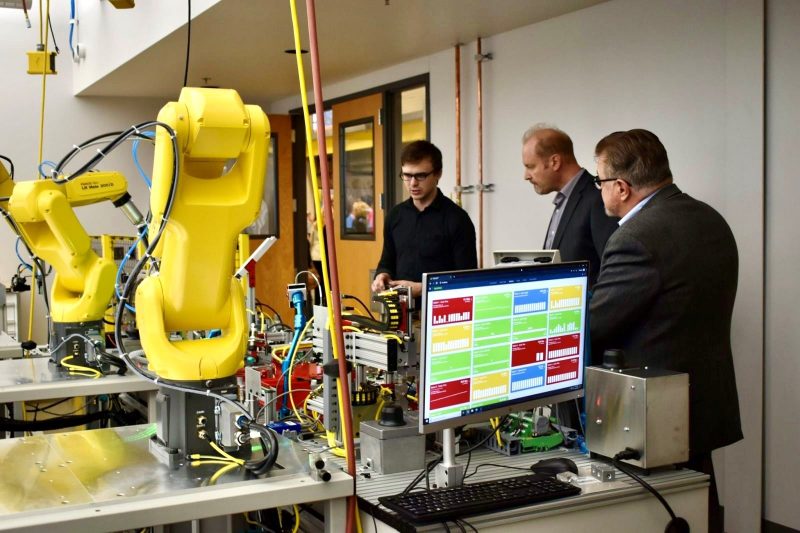Matt Kirchner- President, Lab Midwest & Dr. Joshua Gamer- Dean, Western Technical College discuss IoT and advancing technology
What will work processes look like into the future? How can businesses gain an edge on competition? What are the emerging careers that colleges need to be preparing for? While there is no one answer, it’s becoming clear that the Internet of Things (IOT) is radically changing how businesses and communities can operate. Harnessing this power however requires a skilled labor force and the race is on to embrace new technologies and applications and to develop new academic programs to support a market which shows no signs of slowing.
By some estimates the number of devices that will be connected to the internet will reach 36.8 billion (Juniper Research, 2020). The Internet of Things (IoT) and the smart sensors and devices that comprise it are transforming the world in which we live; a world of refrigerators that track what is in them, record how long the contents have been there and can even create shopping lists based on what containers are running low. Smart cities track everything from emergency services and energy consumption to traffic and trash collection in real time. In manufacturing, production equipment utilises the IoT to gather information about equipment health and then, leveraging powerful cloud analytics, can predict its own future failure and order its own replacement parts before the failure ever happens.
At the core of the IoT are smart sensors and devices including smart phones, televisions and cameras, as well as technology that tracks light, temperature, moisture, air quality, vibration and a myriad of other variables and conditions. Driving the proliferation of these sensors and devices is the technology embedded in them. How does it work? First, communications technology facilitates information sharing between smart sensors and devices. Then, advanced processing and data analytics capabilities enable these smart sensors and devices to analyse the data they collect and send only the pertinent data to networks, data collectors and the cloud, where the data can be further analysed. These communication and data analytics capabilities overcome traditional bandwidth and speed constraints, former impediments to the implementation of smart technology. This, combined with the impact of Moore’s Law (products double in price performance every twelve to eighteen months), is leading to a so-called quadruple threat, in which sensors and devices simultaneously become more capable, faster, smaller and less costly, which in turn causes the number of such sensors and devices to multiply exponentially, permeating every corner of the economy.

With the exponential growth in smart sensors and devices comes exponential growth in available data and the purposes for which it can be used. Consider a single autonomous vehicle operating in a city and loaded with smart technology that tracks every variable associated with its operation — speed, acceleration, the location of an obstruction, weather, road and traffic conditions, traffic lights, and so on. This data is parsed at the sensor and device level and then sent to the cloud where it is analysed. The “conclusions” are then sent to tens of thousands of other autonomous vehicles, making every individual vehicle as smart as all the vehicles collectively and creating a safer and more efficient experience for autonomous vehicle passengers, other motorists and pedestrians.
No market, employer or space is immune from the IoT transformation. Healthcare, distribution, logistics, education, retail, government, finance, insurance, manufacturing, and agriculture are just some examples of market sectors being fundamentally transformed by smart technology. However, while the applications of smart technology differ from sector to sector, the base technologies (smart sensors and devices, control systems, data collectors, cloud computing, cyber security, software execution and resource planning systems, digital twins, augmented and virtual reality systems, quality systems, data science and data analytics) follow similar patterns and leverage like technology. Thus, skills and competencies learned in one IoT market space can be efficiently ported to others.

Due to the explosive growth, and applications of IoT devices, there is also becoming a greater need for skilled technicians within this field. With very few IoT specific degrees available within the United States, colleges are faced with a challenge and opportunity. One specific challenge may require changing how academic and vocational programs are built and managed. In both two and four-year colleges, program curriculum, faculty, advisory committees, planning, and resources are often siloed into different departments, divisions, or colleges. This becomes problematic as careers in IoT are now connecting previously disconnected skill sets as discussed earlier. The business skills of data analytics, the science skills of information technology and web programming, and the engineering skills of device applications and system integration often reside in different organisational units. While some future career opportunities will require specialisation in one of these areas, others will require a fundamental understanding of many facets resulting in a need for increased collaboration in planning, development, and program management within an educational institution.
Western Technical College in LaCrosse, Wisconsin has recently leveraged National Science Foundation support to create a first of its kind associate degree program, encompassing a multitude of skills from different programs and divisions within the college. The Internet of Things Integration Specialist degree prepares students through an understanding of connected devices, and their management, from the sensor level to the cloud. With skills in cyber security and networking, data analytics, machine learning, web programming, PLC’s, robotics, tag-based HMI systems, and mechatronic system integration, students complete a program free of traditional academic boundaries or divisions. The broad focus also prepares them to work in numerous industry sectors, bringing expertise to any organisation looking to improve its productivity and make better operational decisions. Academic programs like this one are needed quickly as the field of mechatronics continues to evolve and grow. More information on this program can be found at https://www.westerntc.edu/node/14945/academic-programs/iot-integration-specialist/courses

This material is based upon work which is supported by the National Science Foundation under grant no. 1801063. Any opinions, findings and conclusions or recommendations expressed in this material are those of the author(s) and do not necessarily reflect the views of the National Science Foundation.

For more information on the project or article, please contact Dr. Gamer at GamerJ@westerntc.edu or Matt Kirchner at mkirchner@labmidwest.com














